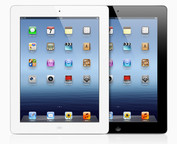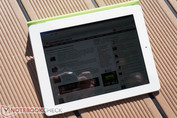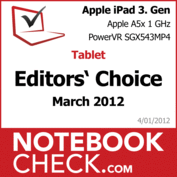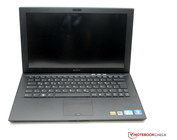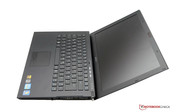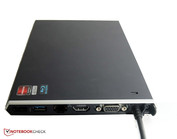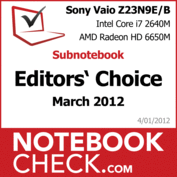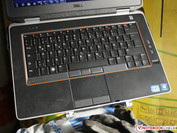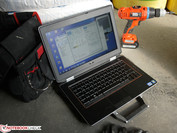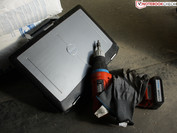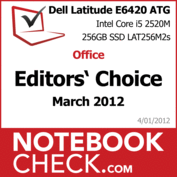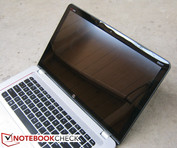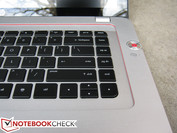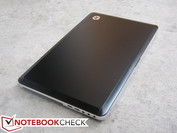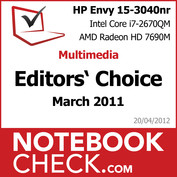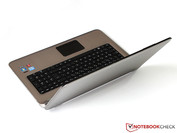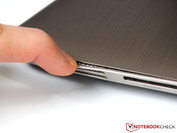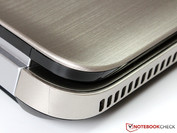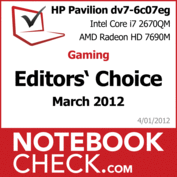Notebookcheck's Best of March 2012
We reviewed an interesting range of mobile computers during the month of March 2012. All categories were represented, from flat tablets (Apple iPad 3rd Gen), to subnotebooks, (Sony Vaio VPC-Z23N9E/B), to noble all-rounders, (HP Envy 15-3040nr) to big gamers (HP Pavilion dv7-6c07eg).
Gamers might be excited about the GeForce GT 640M mainstream Kepler GPU which was used in our Acer Aspire M3-581TG (ultrabook) test sample. On AMD's part, the Radeon HD 7690M plays an important role. Used in the HP Envy 15-3040nr, it's a competent midrange chip. Furthermore, we reviewed the 3D model of Toshiba's Qosmio X770, featuring a far better display than our first test model. The Radeon HD 7690M XT is brand new and allows for games in full HD, but HP's Pavilion dv7-6c07eg (1600x900) requires an external display for it.
In extensively scrutinizing Apple's iPad 3, we also did not neglect tablets. A lot of positive and negative comments on our review prove that the whole world is interested in the iPad. The majority of our editors judge it favorably. In particular, they appreciate the Retina display, which features a pin sharp definition, but is unfortunately darker than its predecessor.
Tablet/MID
More color, less brightness. More graphics performance, but also more waste heat. The iPad is technologically advanced and features the best built-in tablet display to date: a retina display with a very fine resolution of 2048 x 1536 pixels. On the one hand its display isn't as bright as the Asus Transformer Prime (IPS), but on the other hand it nearly covers the sRGB spectrum. Contrary to the best Android tablets, the Apple only features two instead of four CPU cores. So only the graphics performance has improved compared to the iPad 2.
Samsung's Series 7 does not only consist of gaming machines but also includes handy midget PCs, e.g. 11.6-inch tablets or slate PCs. The Series 7 XE700T1A-H01DE features a Core i5 (low voltage) CPU and a 64 GB SSD. Its price of 1,300 Euro is steep, but it comes with an excellent touch display (IPS, wide viewing angles, very bright), built-in UMTS, a docking station and a Bluetooth keyboard. The Slate does not have more interfaces than Android tablets, but at least has a standard USB port. We did not find any serious flaws, but the usability of Windows 7 is disappointing. Furthermore, we used Samsung's Slate in the article Windows 8 Consumer Preview as Tablet-OS in Review and the tester appreciated that everything ran very smoothly.
Toshiba's AT200 wants to be one of the thinnest tablets. The 10.1-incher with OMAP 4430 and Android 3.2 is only 7.7 mm thick and 535 grams. Unfortunately, it's a bit fragile.
The bright IPS display with decent viewing angles can also be used in the sun - something that is not possible at all with the following Medion Lifetab. We liked the docking port and its good battery life of above 10 hours in our WiFi test. Missing Windows 7 64-bit drivers (therefore, it is not possible to connect it to x64- or XP-PCs) spoil our impression.
The offer from ALDI came with a lot of accessories: The Medion Lifetab P9516 32GB+3G includes a USB adapter cable (USB host function), a USB-to-PC cable, an HDMI cable, a headset with integrated microphone, a bag, a matte screen protector, a cleaning cloth, a SIM card, and needless to say a power adapter. We never reviewed a Tegra-2 tablet with that many accessories before. The price of 400 Euro appears to be very attractive. Unfortunately there was a serious problem: The brightness of the screen is only 213 cd/m² (average). Despite matte screen protector this too low for bright daylight. Furthermore, the workmanship was hit or miss and the Lifetab sticker on the front came off of its own accord.
Tablet/MID of March 2012: Apple iPad 3rd Gen 2012-03
The Apple iPad 3 came, saw and conquered. The 9.7-incher won first prize of our top ten tablets straightaway. In terms of points it equals the Eee Pad Transformer Prime TF201, which also got a rating of 89%. The other three tablets in this lap do not stand a chance against it. There are two reasons for this: The Samsung Series 7 is dissimilar as it is a Windows Slate and targets a different group. Toshiba's AT200 and the Medion Lifetab P9516 feature excellent battery life, but drop points in display (Medion) and workmanship (Toshiba, Medion).
What we like
How Apple again sets standards and brings innovation to the market.
What we'd like to see
As always in iOS devices - a bit more openness.
What surprises us
No doubt the high resolution IPS screen. It's perfect aside from the middling brightness.
The competition
The now price-reduced iPad 2 with a lower screen resolution, Asus' Transformer Prime quad core tablet and the upcoming Full HD Android tablets from Acer and Asus.
Subnotebook
Contenders:
Dell XPS 13 84%
HP Folio 13-2000 84%
The first contender is the update of the Sony Vaio VPC-Z23N9E. The 13.1-incher with Core i7 2640M and 2x256 GB SSDs in Raid-0 is technologically advanced. Even the display, a component often neglected in laptops, almost completely covers sRGB. The matte display is fun outdoors, but for an expensive 3000 Euro subnotebook the vertical viewing angle is too narrow. The Power Media-Dock with AMD Radeon HD 6650M is now technically mature (OpenGL issue) and is a good solution for occasional gamers.
Lenovo's ThinkPad X130e targets a completely different group for notably less than 500 Euros. The AMD E-450 performs accordingly, but the laptop features the workmanship of a typical ThinkPad. The pliable case of the older X121e has been corrected. The battery life of seven hours is decent and exceeds the Vaio Z23. The matte display is nice, but too dark. Remarkable: The X130e (85%) and the high-end Vaio Z23N9E (88%) are close in terms of rating. The ThinkPad X130e demonstrates: Good subnotebooks are also available on the cheap.
Ultrabooks should not be missing either. This time they are from Dell, HP, and Samsung. The Texans enter the new market with a 13.3-incher. The tester appreciated the excellent workmanship (carbon fiber, low weight) and the keyboard light of the Dell XPS 13 ultrabook. Its SSD and low voltage Core i7 ensure a first-rate system performance. However, the rating is not perfect because of the high waste heat and the weak display (reflective, low-contrast). The battery life of five hours isn't great. However, HP's Folio 13 and Samsung's 530U3B aren't much better (five and six hours respectively in the wifi test).
HP's Folio 13 packs a Core i5 2467M (low voltage) and a 128 GB SSD into a 19 mm chassis. Its key feature is the flat display with an extremely small frame. We liked the noble design, the good battery life and the high system performance. As usual the display misses a good rating (too dark, poor contrast, poor viewing angles) and it produces too much waste heat.
Despite different qualifications Samsung's 530U3B-A01DE achieves the same rating of 84%. The 13.3-inch display is neither in contrast nor in viewing angles better than HP's Folio. Due to the matte surface and higher brightness the Samsung is nevertheless a good companion outdoors. The battery life of above six hours is excellent and so are the input devices. A weak point is the waste heat produced under high load, where its temperature rises to 57 degrees on the underside. Compared to HP's and Dell's ultrabooks Samsung does not use a genuine SSD but - typical Samsung - an SSD cache. In return the price of less than 700 Euro is attractive.
Subnotebook of March 2012: Sony Vaio VPC-Z23N9E/B
The performance of the Core i7 2640M processor is impressive. In addition, the tester was amazed that it did not throttle: The turbo boost clock hovers between 3.2 GHz and 3.4 GHz. That's indeed remarkable inside a case that is only 16.6 mm high.
What we like
High application performance owing to the swift CPU, and the two RAIDed SSDs are especially notable.
What we'd like to see
Superior speakers could definitely be installed in such an expensive subnotebook.
What surprises us
The OpenGL issue seems to be solved. However, the external HD 6650M apparently can't always call up 100% of its theoretical power reserves in gaming mode.
The competition
Apple's MacBook Pro 13, the previous Sony Vaio VPC-Z21Q9E/B, Samsung's 900X3A, and in view of size as well as portability, even some current ultrabooks such as the Asus UX31.
Office
Contenders:
HP Probook 6360b 84%
In March, we had extremely different Office laptops under review. On one side the semi-ruggedized 14-inch Dell Latitude E6420 ATG got a lot of points. Because of weaker outer and inner components, four cheap competing laptops did not stand a chance against the very stable construction. Being equipped with an SSD and a Core i5, the performance of the E6420 is very good. A lot of docking options and many interfaces are standard in the business range.
The Acer TravelMate 6595 also features a lot of interfaces, although the 15.6-incher does not cost 2,000, but only 900 Euro. The non-reflective business notebook is compatible with Acer's ProDock. In addition to the good battery life of about five hours, the build-in 3G/UMTS module is of interest. Acer does not use a fast SSD in this price range and as so often, the display does not delight us. Because of weak contrast and low brightness, the colors are not crisp and the notebook cannot be used in the sun. Too bad! The solid Travelmate 6595 could have been an overall successful mobile computer.
In terms of display, HP's ProBook 6360b (LY435EA) has similar weaknesses (poor contrast / brightness) and comes with similar docking options as the TravelMate 6595 for a similar price. Despite the same rating, we think that the TravelMate is the better Office notebook as the display of the Probook is too dark (in daylight) and the system noise is permanently too high. The case is typical Probook, solid, but some keys of the 15.6 incher are too small.
We had the US-model N4110 of Dell's Inspiron 14R, a genuine consumer machine with Core i3 2330M and reflective 14-inch HD display under review. The computer from the Texans actually does not fit into this Office competition as it has neither a variety of interfaces nor a docking port. The only other flaw of the Inspiron is its low-contrast display with narrow viewing angles. At least waste heat and system noise are kept within a limit and the performance is overall decent.
Acer's 5744Z-P624G50Mikk is the second Travelmate in this competition. It focuses on an attractive price below 400 Euro. In return customers have to accept lower performance (Intel Pentium P6200), fewer interfaces (no docking port, no HDMI) and a weaker display (lower brightness). This is unfortunately also true for the keyboard: the feedback is imprecise and there is a clacking noise during typing. Because of its short battery life of only two hours the 15.6-incher does not deserve to be called Travelmate. At least the boring plastic chassis is rather solid, the display non-reflective and heat and noise emissions are extremely low.
Office notebook of March 2012: Dell Latitude E6420 ATG
Due to its rating Dell's Latitude E6420 ATG easily won the title. Perfect input devices, high performance, and excellent suitability for daily use owing the semi-rugged design increase the rating. Sales prospects working in harsh environments probably won't mind its very high weight of 2.9 kg.
What we like
The awesome brightness will appeal to sun worshipers and everyone who works in a very bright environment.
What we'd like to see
A higher resolution, at least as an option in the shop.
What surprises us
The long battery runtime with the "small" 6 cell battery and the low noise level.
The competition
Without semi-rugged: Lenovo Thinkpad T420, HP Elitebook 8460p
Semi-rugged: Panasonic Toughbook S10 / F9, Getac S400, Wortmann TERRA Mobile INDUSTRY 1280
Multimedia
Contenders:
Lenovo IdeaPad U400-09932DU 82%
Medion Akoya P6633 (MD97958) 79%
Acer Aspire 5750G-2354G50Mnkk 78%
The six multimedia all-rounders range from HP's Envy 15 performance bolide, to Acer's brand new Timeline Ultra M3 with GeForce GT 640M (ultrabook), to the cheap Asus X54HR multimedia laptop with Core i3.
HP offers a luxury laptop, the Envy 15: Core i7 quad core, AMD Radeon HD 7690M inside and great design outside (aluminum alloy, high stability). The 15.6-inch full HD display is a mixed bag. We enjoy its good brightness, wide viewing angles and high contrast. Unfortunately the highly reflective Radiance display does not output red accurately, but it appears intensively orange. Speaker quality and fast CPU are positive aspects. It's a pity that HP will not launch the Envy 15 in Germany for now.
Intel watered down the ultrabook criteria, and Acer launched the Aspire M3-581TG as Timeline Ultra. As it only weights two kilograms the 15.6-incher is really light. We like the Geforce GT 640M (mid-range) combined with a low voltage Core i7 and a 256 GB mSATA-SSD (LiteOn LMT-256M3M). Its performance is solid, but not the price of about 1,200 Euros (MSRP). What's new is that there are many interfaces on the rear. However, the low-contrast display is improper for such a bolide. In addition the Aspire M3 gets very hot under load.
Lenovo's IdeaPad U400-09932DU does not get that hot, but also offers less performance. We reviewed the US model of the smart 14-incher. The tester liked its stable and high-quality construction. But, the reflective display spoils the party. In addition, viewing angels are narrow and contrast is very low. The low weight of less than two kilograms and the rather good performance without SSD are remarkable.
Medion provided us with the moderate 15.6-inch Akoya P6633. The matte full HD display is not very reflective and has nice colors. Even the viewing angles are not too narrow. Not bad for a 750 Euro notebook that also comes with a GeForce GT 630M and a Core i5 2450M. However, the case spoils the bonus. It is completely finished with piano coating, even the touchpad was not excluded. The rating of 79% reflects the disappointment of the tester.
Acer's Aspire 5750G-2354G50Mnkk has an aggressive price. The customer actually gets a small dedicated graphics card (GT 610M) and a Core i3 processor for 500 Euro. We appreciate the battery life of 4:24 hours and the always cool case. However, gamers will be disappointed by the weak graphics card and the low-contrast display with narrow viewing angles. In addition the workmanship is not flawless and the keyboard suffers from weak feedback.
The X54HR-SO060V from Asus is even cheaper. In terms of performance the 15-incher features the same components as the Aspire 5750G and unfortunately also repeats some of the Aspire's flaws: The colors of the display appear dull and the viewing angles are narrow. But, there are also some pros: The display is non-reflective and the laptop features an aluminum chassis of higher quality. Because of the short battery life of just two hours and the clacking keyboard it got a very low rating of 75%.
Multimedia notebook of March 2012: HP Envy 15-3040nr
Despite its clear weaknesses, the HP Envy 15 wins clearly according to points. The incorrect color reproduction is its biggest shortcoming. Professional graphic designers can't accept this. Unfortunately HP will not launch its 15-incher in Germany. Therefore our review will be rather of interest in the US. In Germany, HP offers the HP Envy 14 Spectre (ultrabook), the HP Envy 14-2000eg (Multimedia), and the HP Envy 17-3010eg (DTR; Radeon HD 7690M XT).
What we like
In terms of hardware, the 2012 Envy 15 is built superbly to reflect its price. Sound quality is better than expected and overall performance in both applications and graphics should be more than good enough for everyday users. We especially appreciate the ease of disassembling the notebook.
What we'd like to see
As much as we think the IPS display is brilliant, its poor color accuracy is the largest drawback of the notebook. Other downsides, such as the touchpad, non-XT 7690M GPU, fan noise and super-glossy display are relatively minor complaints comparatively.
What surprises us
The overall design is the best yet for the Envy series. While we still disagree with having the Beats Audio logo branded three times all over the chassis, the sound system, analog volume knob and control options all make music and video playback a lot more fun.
The competition
MacBook Pro 2011, Acer Travelmate 5744Z, HP Pavilion dv7-6c07eg, Envy 17 3D 2012, Acer Aspire 5755G, MSI GT780DX.
Gaming/DTR
We reviewed two competing DTRs in March. HP's 1000 Euro Pavilion dv7 is the cheaper offering. For this steep price HP includes fast hardware: an up-to-date Radeon HD 7690M and an Intel Core i7 2670QM. As a result the gaming performance is excellent even on an attached Full-HD display. Unfortunately the built-in 17-inch display misses all criteria important for demanding customers: Its colors are weak, the viewing angles narrow and the surface is reflective. But, the tester liked the stable aluminum case, the Blu-ray drive and the 1,000 GB hard drive.
The reviewed Toshiba Qosmio X770-11C is an updated model. Compared to our first review of the X770-10J (Core i7 2630QM) the CPU was updated (2670QM) and it features a 3D display with better colors and viewing angles. As a result it gives a balanced DTR that not only features high gaming performance (GeForce GTX 560M) but also a real good display. However, the price of 1,400 Euros for the 3D model is rather steep.
DTR/Gaming notebook of March 2012: HP Pavilion dv7-6c07eg
The ratings are equal. Why do we elect HP's Pavilion dv7-6c07eg despite its weaker display. The Pavilion offers nearly the same gaming performance, superior battery life and a slightly smaller chassis than the Qosmio for less money. The Qosmio X770-11C is the better choice for customers focusing on display quality or wanting to play 3D games.
What we like
Exceptional performance for a fair price - this argument will attract buyers to the Pavilion dv7. The great hardware components and stylish yet sturdy case are also worthy of praise.
What we'd like to see
Unfortunately, the notebook does not use the amazing Full HD display found in the other configuration of this model. Low contrast and unstable viewing angles are the result. In addition, the manufacturer should pay more attention to workmanship flaws such as gaps in the material and parts.
What surprises us
Despite four speakers and a subwoofer, the sound quality of the notebook is not what we would have hoped for.
The competition
The Dell XPS 17 and Asus N75SF use a GeForce graphics card and are two of the fiercest competitors. The HP Envy 17 is another high-quality and impressive alternative.




